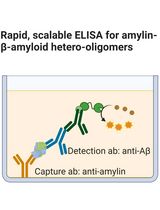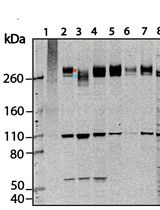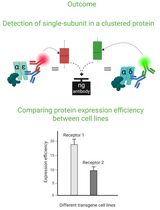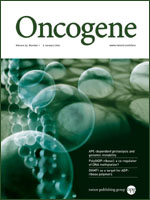- Submit a Protocol
- Receive Our Alerts
- Log in
- /
- Sign up
- My Bio Page
- Edit My Profile
- Change Password
- Log Out
- EN
- EN - English
- CN - 中文
- Protocols
- Articles and Issues
- For Authors
- About
- Become a Reviewer
- EN - English
- CN - 中文
- Home
- Protocols
- Articles and Issues
- For Authors
- About
- Become a Reviewer
Analyze p53 degradation by 35S p53 Pulse Chase Analysis
Published: Vol 2, Iss 21, Nov 5, 2012 DOI: 10.21769/BioProtoc.283 Views: 10068

Protocol Collections
Comprehensive collections of detailed, peer-reviewed protocols focusing on specific topics
Related protocols

Detection of Amylin-β-amyloid Hetero-Oligomers by Enzyme-Linked Immunosorbent Assay
Noah S. Leibold [...] Florin Despa
Feb 5, 2025 1388 Views

Western Blotting and Immunoprecipitation of Native Human PIEZO1 Channels
Jinyuan Vero Li [...] Charles D. Cox
Jul 20, 2025 3446 Views

Cluster FLISA—A Method to Compare Protein Expression Efficiency Between Cell Lines and Subunit Clustering of Proteins
Sabrina Brockmöller and Lara Maria Molitor
Nov 5, 2025 1158 Views
Abstract
p53, is known as the guardian of the genome and as such requires exquisite regulation not only of its abundance but also its activity. The abundance of p53 can be modulated at the level of transcription, translation, and also via its degradation.
This protocol involves 35S metabolic labelling of newly synthesized proteins followed by a period of chase with "cold" media. Samples are harvested and p53 immunopreciptiated, separated by SDS PAGE and the levels of 35S labelled p53 determined. By comparing the level of 35S p53 at 0 h to those "chased" with cold media (e.g. 60 min) provides an indication of the rate of p53 turnover.
Materials and Reagents
- Dulbecco’s Modified Eagle Medium (DMEM) methionine and cysteine free media (1x) (Life Technologies, Invitrogen™, catalog number: 21013-024 )
- Dialysed fetal bovine serum (FBS) (Life Technologies, Invitrogen™, catalog number: 26400-036 )
- Express 35S protein labelling mix (PerkinElmer, catalog number: NEG 0720008MC )
- Cell lifter (Corning Incorporated, catalog number: 3008 )
- Protein A sepharose (Zymed, catalog number: 10-1042 )
- p53 DO-1 (Santa Cruz, catalog number: SC-126 )
- DC Protein assay kit (Bio-Rad Laboratories, catalog number: 500-0116 )
- Bio-Rad safe stain solution (Bio-Rad Laboratories, catalog number: 161-0786 )
- L-glutatmine or Glutamax (Life Technologies, Invitrogen™, catalog number: 35050-061 )
- cOmplete Ultra tablets (Roche Applied Science, catalog number: 05 892 988 001 )
- PhosSTOP tablets (Roche Applied Science, catalog number: 049068450001 )
- NP-40 (IGEPAL, catalog number: CA-630 )
- Beta mercapotethanol
- Bromophenol blue
- Complete media (see Recipes)
- Starvation media (see Recipes)
- Dulbecco’s PBS (see Recipes)
- 1x lysis buffer (see Recipes)
- 2x SLB buffer (see Recipes)
- Washed protein A sepharose (see Recipes)
Equipment
- Bioruptor sonicator (Diagenode)
- Macsmix tube rotator (Miltenyi Biotech GmbH) or standard Rotating wheel
- Heat block
- SDS–polyacrylamide gel electrophoresis (PAGE) running equipment
- Orbital shaker
- 3 mm whatman paper and plastic wrap
- Gel Dryer and pump
- Storage phosphor screen (Molecular Dynamics) and Typhoon Trio (GE Healthcare)
Software
- Image Quant software (Molecular Dynamics)
Procedure
- Labelling
- Cells were plated in complete media at 350,000 per 100 mm plate 48 h before harvesting (this will be cell type dependent, aim for 70% confluence at day of harvest).
- Aspirate media and wash the cells gently with room temperature (RT) PBS (10 ml per 100 mm plate).
- Remove PBS and replace with warmed (37 °C) starvation media (6 ml per 100 mm plate).
- Return cells to the incubator for 1 h.
- Add 200 μCi of Express 35S protein labelling mix (18 μl per dish) directly into the media and swirl.
- Return to the incubator for 30 min.
- Either:
- Harvest (0 h)
- OR remove the media and wash the plate twice with 5 ml of warmed complete media.
- Add complete media and return plates to the incubator for the designated period of time (15 min, 30 min, 45 min, 60 min) before harvest.
- Harvest (0 h)
- Cells were plated in complete media at 350,000 per 100 mm plate 48 h before harvesting (this will be cell type dependent, aim for 70% confluence at day of harvest).
- Harvest (Keep samples cold at all times)
- Place plates on ice and remove the media.
- Wash plates gently twice with 5 ml of ice cold PBS, then drain the plate on its side and remove any residual PBS.
- Add 500 μl of lysis buffer with 0.5% NP-40 and scrapped with a cell lifter.
- Pippette lysate into a 1.5 ml Eppendorf tube.
- Sonicate lysate for 5 min with a cycle of 30 sec on then 30 sec off at 4 °C using the Bioruptor.
- Spin sample at 11,000 x g for 10 min at 4 °C.
- Transfer supernatant to a new tube keeping them on ice.
- Determine the protein concentration of sample using the DC Bio-Rad assay as per manufactures instructions with BSA as a control. Samples were assayed in triplicate.
- Place plates on ice and remove the media.
- p53 Immunopreciptiation
- Equivalent amounts of protein were added to each tube and made up to a final volume of 400 μl with lysis buffer.
- To each sample add 40 μl of washed protein A sepharose to preclear the sample.
Note: Beads are in a 50% slurry so the final bed volume is 20 μl; use a tip which has the last 20% cut off the end to generate a larger bore size, pipette up and down at least 5 times to insure the beads are not stuck in the tip. - Rotate sample for 1 h at 4 °C on wheel.
- Spin sample at 800 x g for 2 min at 4 °C.
- Transfer supernatant to fresh tube and:
- Remove 20 μl to keep as "input" for loading control purposes.
- Add 40 μl of a 50% slurry of washed protein A sepharose with 0.3 μg of p53 or control antibody.
- Remove 20 μl to keep as "input" for loading control purposes.
- Tumble overnight at 4 °C.
- Spin at 800 x g for 2 min at 4 °C.
- Remove supernatant and wash beads with 600 μl of lysis buffer with 0.1% NP-40 three times (flick tube to resuspend beads don’t pipette them).
- Spin sample at 800 x g for 2 min at 4 °C.
- Remove supernatant and wash beads with 1 ml of Lysis buffer with no NP-40 two more times.
- Spin sample at 800 x g for 2 min at 4 °C.
- Remove all supernatant and add 40 μl of 2.5x SLB buffer.
- Boil beads at 95 °C for 10 min in a heatblock.
- Cool on ice for 5 min.
- Boil for a further 5 min in a heat block.
- Pulse spin at max speed for 30 sec.
- Transfer supernatant to new tube (~50 μl/sample).
- Load input, immunoprecipitation and markers on a 10% PAG with 4% stacker, 1.5 mm thick, 10 well comb, then run the gel at 100 V for about 2 h (stop when dye is almost at the bottom of the gel).
- Remove gel from the plates and wash gel twice with ddH2O.
- Stain the gel in Bio-Rad safe stain solution for 1 h while gently rotating on an orbital shaker.
- Replace the stain and incubate for a further 20 min while gently rotating on an orbital shaker.
- Remove gel from stain and put in a fresh container then add water to destain, refresh the water 2-4 times over 1 h.
- Carefully place the gel on two layers of 3 mm paper, cover with glad wrap and dry using a Bio-Rad gel drier at 80 °C for ~2 h (till no longer sticky).
- Place gel by the phosphoimager screen overnight then analyze with the Typhoon Trio.
- Quantitate the bands using the Image Quant software (Molecular Dynamics).
- Equivalent amounts of protein were added to each tube and made up to a final volume of 400 μl with lysis buffer.
Recipes
- Complete media
1x DMEM
10% FBS
1x Glutamax - Starvation media
Methionine and Cysteine free DMEM
15% dialysed FBS
1x Glutamax - Dulbecco’s PBS (for 1 L)
0.2 g KCl
0.2 g KH2PO4
2.3 g Na2HPO4
8 g NaCl - 1x lysis buffer
Use stock solutions to make the following final concentrations
50 mM Tris (pH 8.0)
150 mM NaCl
5 mM EDTA
1x complete (protease inhibitors)
1x PhosphoSTOP
Plus 0.5% or 0.1% NP-40 (v/v): Add fresh to the buffer using a 10% stock of NP-40, keep cool to help resuspend the NP-40 (IGEPAL CA-630) - 2x SLB
500 mM Tris (pH 6.8)
20% SDS
20% Beta mercapotethanol
0.1% bromophenol blue - Washed protein A sepharose
The protein A sepharose is stored in ethanol which needs to be removed.- Remove 2.5x the volume you need for the experiment
- Pulse spin at 4 °C (Let centrifuge get to maximum speed and then stop)
- Remove supernatant and add 5x the volume in 6 a) of lysis buffer plus 0.5% NP-40
- Repeat pulse spin and repeat wash
- Remove supernatant and add 0.5x the volume in 6a) of lysis buffer to generate a 50% slurry
- Remove 2.5x the volume you need for the experiment
Acknowledgments
This protocol was originally published in its brief version in Astle et al. (2012). This work was supported by grants from the National Health and Medical Research Council (NHMRC) of Australia to RDH (NHMRC Nos. 166908 and 251688) and to RBP (NHMRC Nos. 509087 and 400116) and from Cancer Council Victoria to RBP. RDH and RBP are NHMRC Senior Research Fellows. We acknowledge the Victorian Centre for Functional Genomics for the use of equipment and advice. We thank Professor Stephen Jane and Loretta Cerruti for assistance with retrovirus production.
References
- Astle, M. V., Hannan, K. M., Ng, P. Y., Lee, R. S., George, A. J., Hsu, A. K., Haupt, Y., Hannan, R. D. and Pearson, R. B. (2012). AKT induces senescence in human cells via mTORC1 and p53 in the absence of DNA damage: implications for targeting mTOR during malignancy. Oncogene 31(15): 1949-1962.
Article Information
Copyright
© 2012 The Authors; exclusive licensee Bio-protocol LLC.
How to cite
Astle, M., Pearson, R. and Hannan, K. (2012). Analyze p53 degradation by 35S p53 Pulse Chase Analysis. Bio-protocol 2(21): e283. DOI: 10.21769/BioProtoc.283.
Category
Biochemistry > Protein > Immunodetection
Do you have any questions about this protocol?
Post your question to gather feedback from the community. We will also invite the authors of this article to respond.
Share
Bluesky
X
Copy link









